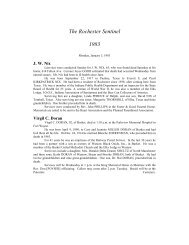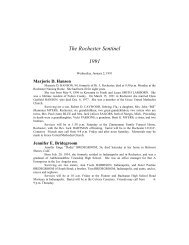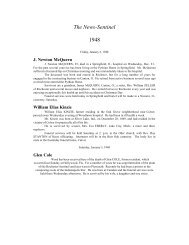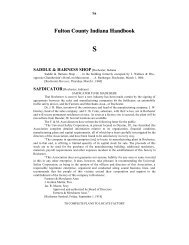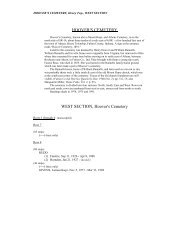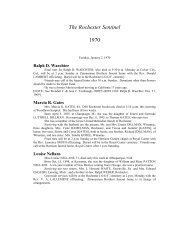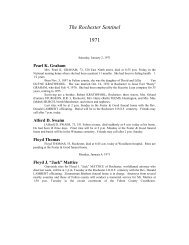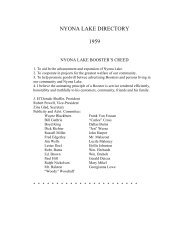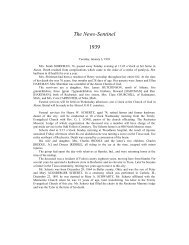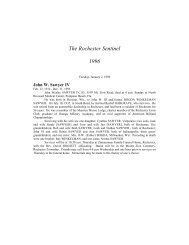Handbook N-P - Fulton County Public Library
Handbook N-P - Fulton County Public Library
Handbook N-P - Fulton County Public Library
You also want an ePaper? Increase the reach of your titles
YUMPU automatically turns print PDFs into web optimized ePapers that Google loves.
Pu<br />
Dr. J. N. Hurty had just received his commission as State <strong>Public</strong> Health impresario, and<br />
Dr. J. W. Irons, who came to Rochester from Logansport in 1892, received the appointment as<br />
health officer for <strong>Fulton</strong> <strong>County</strong>.<br />
Irons was a young man - bright, colorful, efficient. Though only a year in this<br />
community, he had managed to build a very promising medical practice.<br />
He scoffed at the claim that people “caught cold” in open wounds, and propounded the<br />
infection theory. He argued that “Grandma’s neighborly interest” in a case of scarlet fever or<br />
small pox next door, was all right from the neighborly standpoint, but very disastrous from the<br />
health angle. He concurred with Dr. Hurty’s theory that contagious diseases should be<br />
quarantined. And last but not least, he proposed to see that the practice of grocery and meat men<br />
to display their foodstuffs on the sidewalk in front of their stores - there to be at the mercy of flies,<br />
dust and germs, was wrong.<br />
Enforced Law<br />
The first phase of the new public health service was to order foodstuffs removed indoors.<br />
This started a storm of protest from dealers and public alike. A “crank” they called him, from<br />
Logansport was trying to put into effect a lot of citified ideas. Indignant, they refused to comply<br />
with the order. Refusal brought about several arrests and according to those who recall the<br />
occasion, there was cryptic reference to riding the new official out on a rail.<br />
But Doctor Irons stuck to his guns. It was a slow, heartrending ordeal to change the mind<br />
of a community, but when anger had subsided, and calm reflection came, the health program<br />
appeared in its true light. Gradually the information came, and providently it was continued, until<br />
no more do we see the open sugar and coffee barrel, the boxes of dried prunes, covered with dust,<br />
and the platetrs of butter and lard standing exposed to every predatory germ which chanced to<br />
float by.<br />
First Quarantine<br />
The first record of death in a quarantined home occurred in 1896, during an epidemic of<br />
scarlet fever. Prior to that time, an examination of the records of undertakers in <strong>Fulton</strong> county<br />
shows that 75 percent of the deaths recorded were those of children.<br />
This calls to mind the references by older residents to “Black Sunday” in January of<br />
1874, when seven children were buried in I.O.O.F. cemetry in one afternoon, while diphtheria<br />
raged from one end of the country to the other. The toll of this black epidemic stands material<br />
witness to the ignorance of contagion in the public mind of that day.<br />
Sanitation Big Factor<br />
Noticeable, too, in the records pre-dating the innovation of the public health service, were<br />
the deaths by typhoid fever. Open wells, little or no regard for the proximity of stagnant water,<br />
seeping sewage and other health impairing agencies were responsible. To checkmate this, the<br />
Health Officers in regular succession since Dr. Irons have worked diligently to eliminate such<br />
conditions, and as a result typhoid has practically disappeared.<br />
Birth, Death Records<br />
Contrary to the general impression, birth and death certificates were not required by law<br />
until the act of 1899.<br />
Prior to that time - indeed as far back as the early 80’s there was some effort made to<br />
record the vital statistics of the county, but some physicians were lax in their attention to this, and<br />
the result was that many births and deaths were not officially recorded. But with the turn of the<br />
century things changed. Since that time the record is clear and authentic.<br />
A Debt to Irons<br />
That the people of <strong>Fulton</strong> county owe a debt of gratitude to J. W. Irons for the excellent<br />
work done can never by denied. The fact that his efforts to innovate a new and much needed<br />
control of the public health caused so much resentment that he was finally compelled to seek a<br />
new community in which to practice, is indeed an indictment against the sportsmanship and good<br />
judgment of those who whispered against him.<br />
Bur fortunately his work and his unyielding determination to educate the people along the<br />
lines of contagion, infection and sanitation fell to competent hands. In the years which have




